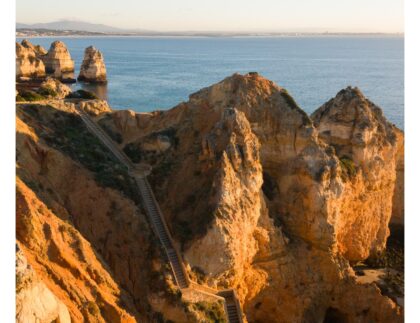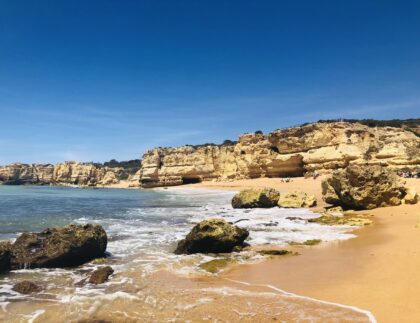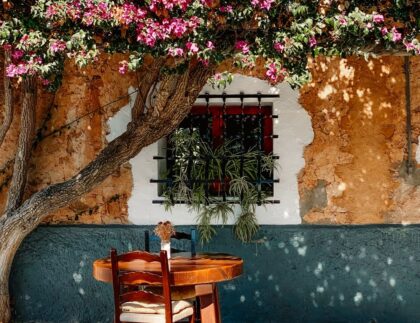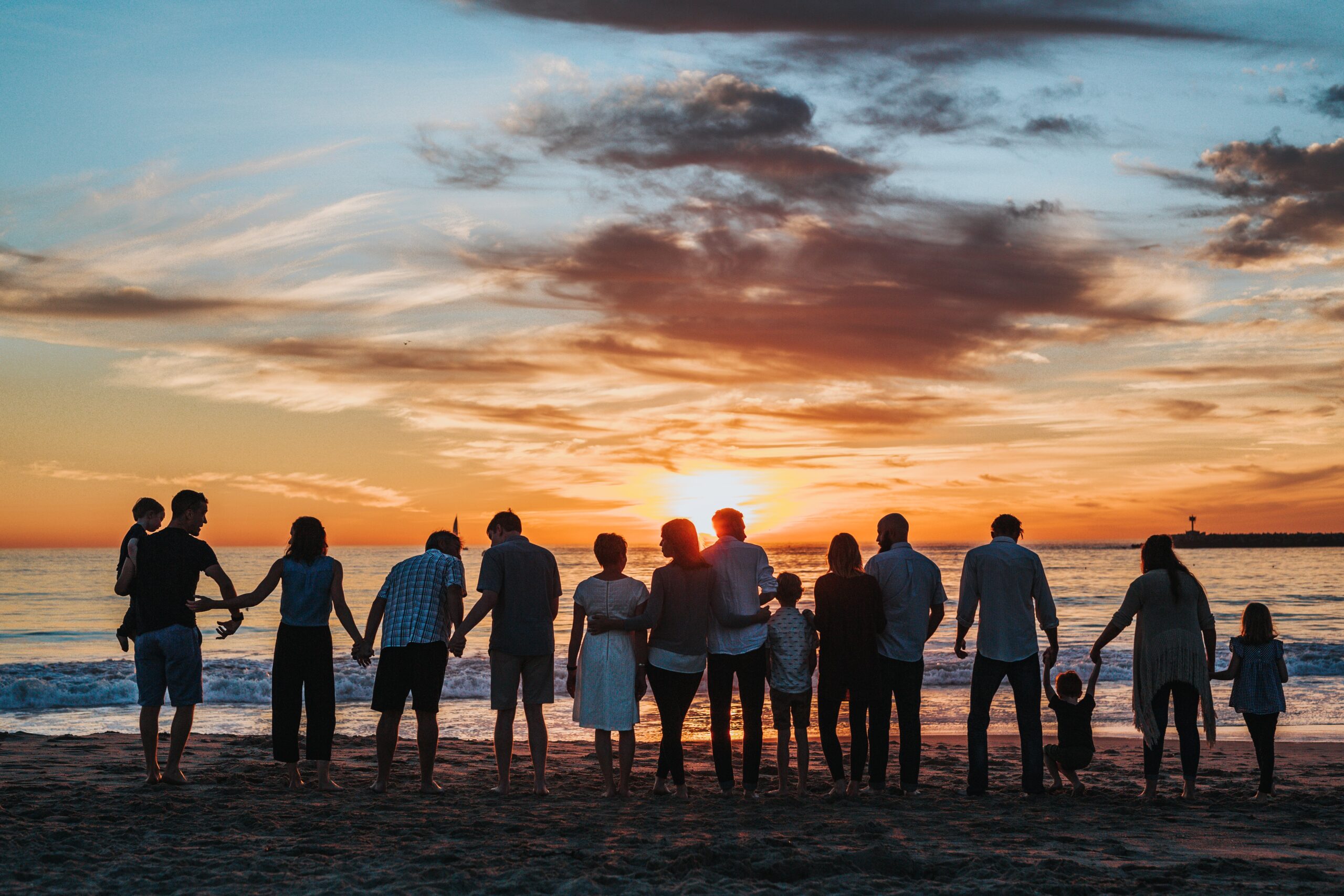
If you are affected by a rural fire
We all hope that we are never in a position where we are threatened by a rural fire, which is an alarming experience.
If unfortunately you do become threatened by a fire it is essential that proper steps are taken to help protect you, your family and property.
Please read this latest program “Safe Villages – Safe People” outlines self-protection measure for the population in the event of a rural fire affecting people and their homes.
Please also read this leaflet which outlines the basic steps to take, translated by Safe communities Portugal, can be downloaded for you to use
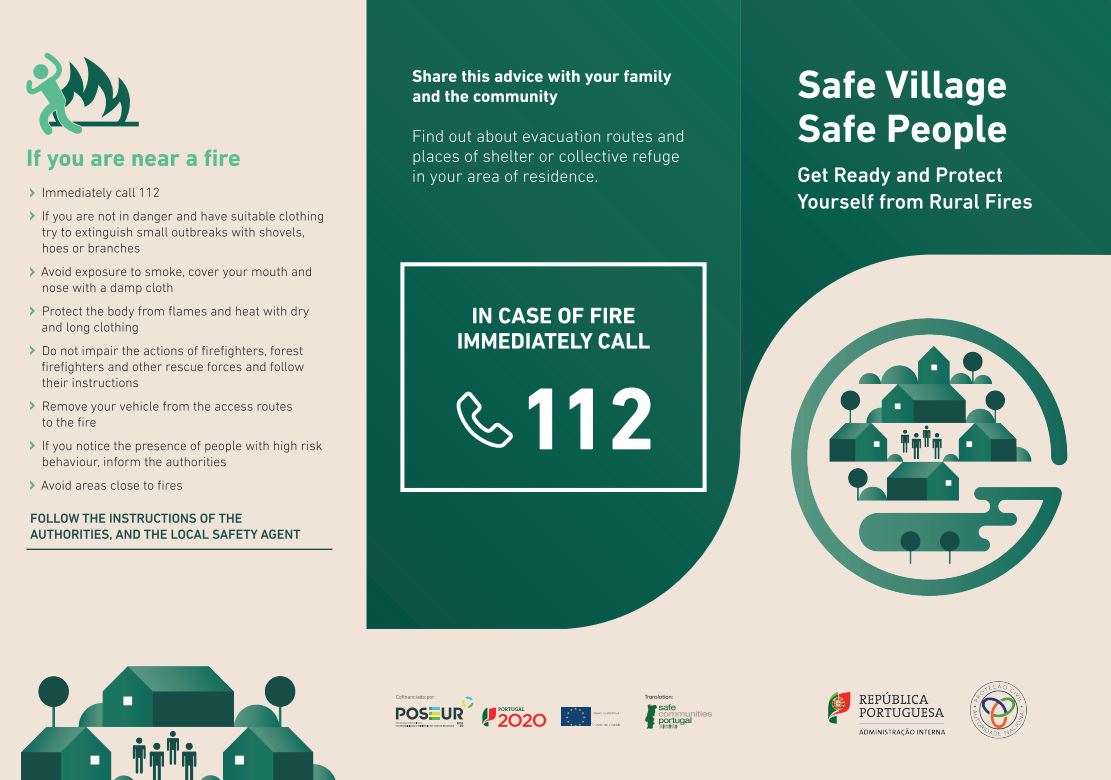
If a fire approaches the home
- Let the neighbours know
- Water walls, roof and 10 meters around the house
- Close doors, windows and other openings, close blinds or shutters
- Remove furniture, tarpaulins or firewood near the dwelling
- If it is safe to do so, disconnect and remove the gas cylinders to a safe place
- Keep away from the windows anything that can burn and put wet towels in the crevices
- If you are not in danger, extinguish small outbreaks with water, earth or green branches
- Follow the instructions of the authorities
If you get surrounded by a fire
- Make your way to a shelter or collective refuge. If you are not near one, look for a preferably flat area with water or little vegetation
- Breathe close to the floor, if possible with a wet cloth, to avoid inhaling the smoke
- Cover your head and the rest of the body
- Use a damp cloth to protect your face from heat and smoke
- Communicate your situation to the authorities through 112
In case of confinement within the building
- Keep calm
- Keep the curtains and sofas away from the windows
- Close doors, windows and other openings that allow the entrance of sparks to the interior
- Place wet towels in the crevices of doors and windows
- Stay away from walls
- Look for shelter in the rooms at the opposite end of the dwelling relative to the side where the fire is approaching
- Wait for the fire to pass, and then check for fire outbreaks surrounding the dwelling and on your roof
- Communicate your situation to the authorities through 112
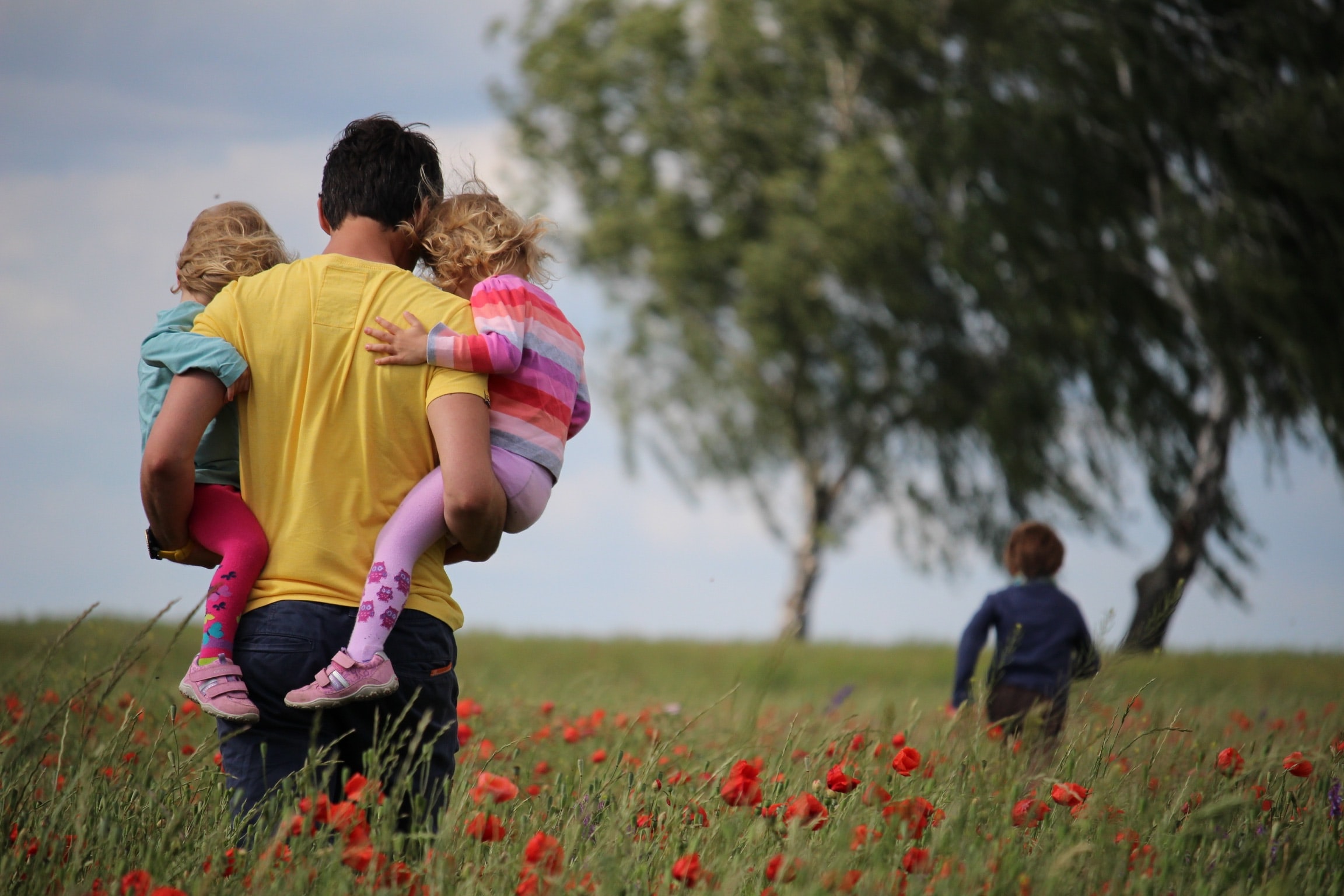
In case of Evacuation
- Keep calm and obey the authorities instructions
- Help children, the elderly and people with mobility limitations
- Take your evacuation kit and identification documents
- Do not waste time collecting unnecessary objects and do not go back
- Close the doors and windows as you move out of the dwelling
- Take pets with you
- Make your way quickly to the nearest shelter or collective refuge
- Comply with authority indications
Have an evacuation kit prepared with:
- First-aid kit - In Villa Cascata this is located in the downstairs bathroom
- Your usual medication
- Water and non-perishable food
- Personal hygiene products
- A change of clothes
- Radio, flashlight and whistle
- Money
- Family / friends contact list
If you are near a fire
- Immediately call 112;
- If you are not in danger and have suitable clothing try to extinguish small outbreaks with shovels, hoes or branches
- Avoid exposure to smoke, cover your mouth and nose with a damp cloth
- Protect the body from flames and heat with dry and long clothing
- Do not impair the actions of firefighters, forest firefighters and other rescue forces and follow their instructions
- Remove your vehicle from the access routes to the fire
- If you notice the presence of people with high risk behaviour, inform the authorities
- Follow the indications of the authorities
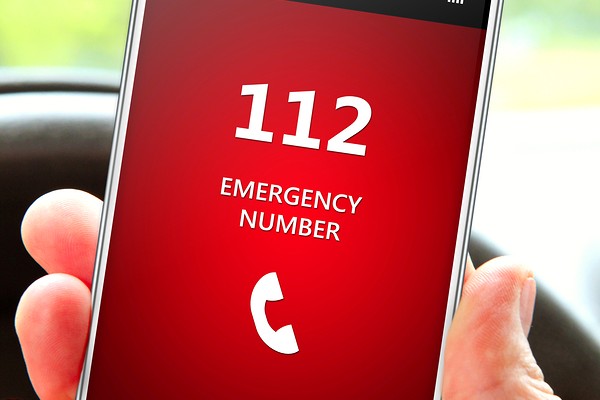
Prepare the dwelling for a quick departure:
- keep the exits of each room and the building free, without objects blocking the way
- ensure that all exits can be opened easily
- have the exit paths chosen and identified (usually a door and a window) to exit each room
- define common meeting points that are known to the whole family
In case of preventive evacuation, carried out in advance to the outside of the cluster:
- Keep calm
- Comply with the evacuation instructions given by the authorities. Don’t go back
- Helping children, the elderly or family members with mobility limitations
- Bring the evacuation kit Don’t waste time collecting unnecessary objects
- Take your pets with you
- Close doors and windows as you leave the house, as well as other openings (eg ventilation grilles) that allow sparks to enter the interior;
- Leave the house’s exterior lights on;
If you have time and security situation allows:
- Move the curtains and sofas that are next to the windows away and remove the garden furniture, canvas and firewood that are on the porches or next to the house
- Turn off and remove gas cylinders to a safe place, for example by immersing them in tanks to minimize the risk of explosion
- Water the housing surroundings (especially the side facing the front of the fire) and the respective roof
- Use the cell phone only when essential
- Follow the instructions disseminated by the authorities through the media or other warning channels
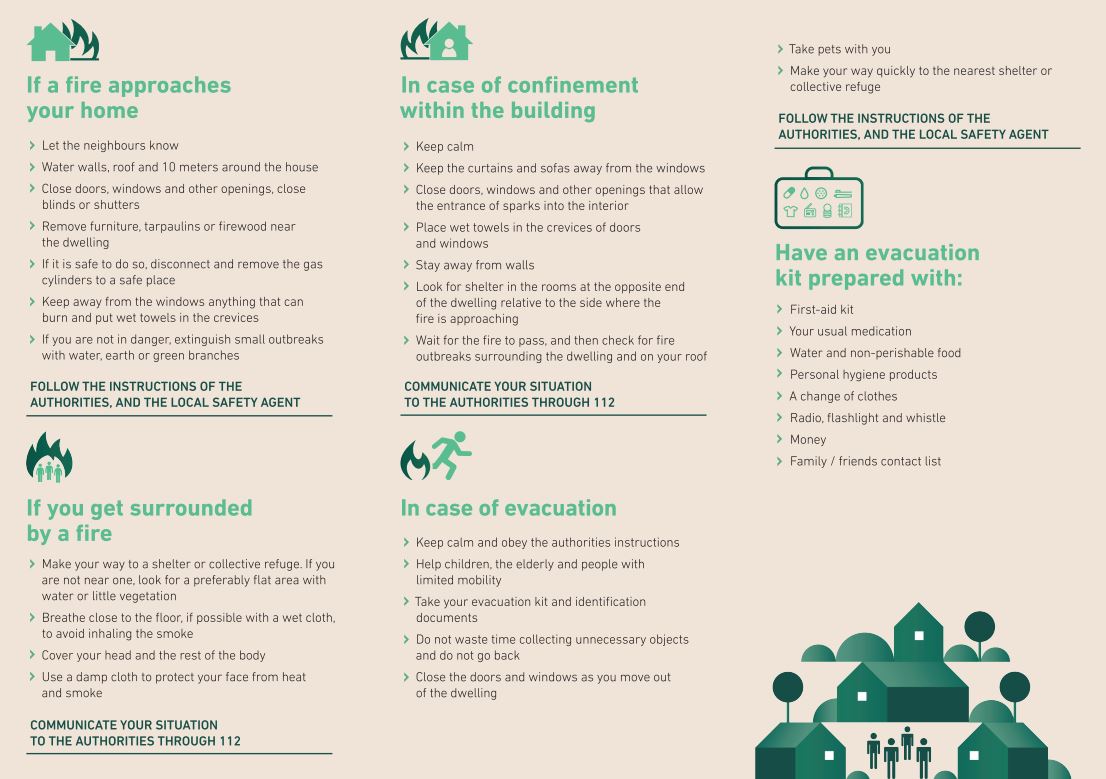
In case of sudden evacuation to a shelter or collective refuge inside the cluster:
- Protect the body from flames and heat with suitable clothing (preferably long-sleeved pants and shirt, gloves and scarf to protect the face from heat and fumes)
- Keep clothes dry (water is a very conductive substance, so wet clothes heat up quickly, which can increase the severity of burns)
- Always choose the safest way out of the house (ie the one with less smoke and heat). If strictly necessary, cross smoky spaces as close to the ground as possible
- Go quickly to the nearest shelter or collective refuge defined within the cluster. Do not go back until further notice
In case of confinement in the dwelling, if it is not possible to escape to a shelter or collective refuge:
- Keep calm
- Protect the body from flames and heat with dry (preferably non-synthetic) and suitable clothing (preferably long-sleeved pants and shirt, gloves and scarf to protect the face from heat and fumes)
- Move the curtains and sofas that are next to the windows away and remove the garden furniture, tarpaulins and firewood that are on the porches or next to the house
- If it is safe to do so, disconnect and remove the gas cylinders to a safe place, for example, immersing them in tanks to minimize the risk of explosion;
- If it is safe to do so, water the housing’s surroundings (especially the side facing the front of the fire) and the respective roof
- Close doors, windows and other openings (eg ventilation grilles) that allow sparks to enter the interior;
- Place wet towels in the cracks of doors and windows
- Stay away from walls
- Seek shelter in the rooms at the opposite end of the house in relation to the side where the fire is approaching
- Place companion animals in a single room in the house and preferably accompanied. Never release animals to the street
- Use the cell phone only when essential;
- Wait for the fire to pass and, later, check the existence of fires in the housing envelope and on its roof
Many people plan to leave for a safer place but leave it too late. You need to identify and agree on a trigger with your family that will prompt you to leave early and have a back-up plan in case you cannot leave in time.
Prepare all the people in your household. Make sure everybody, including children if they are old enough, knows the situation and what steps to take.
A designated meeting location outside the fire area. With many households having more than one car, you may evacuate in separate vehicles and could become separated. Family members may also be in different locations when the fire threatens, so a known safe meeting point is very important to determine that everyone has safely evacuated from the affected area.
If you urgently need to call the emergency services, which usually can understand English, pronouncing your address in Portuguese may not be recognised right away, particularly if you are upset and not able to think very straight. Also some rural addresses in Portugal are no more than a village name – no house number or street name, so a GPS co-ordinate will pin-point your house. The Portuguese emergency services can access Google Maps so using this GPS format will be best.
The different escape route plans from your home and/or area. Ideally work out at least two routes, preferably more, and practice driving them if they are not familiar to you already. Program these escape routes into your vehicle GPS device so you know where you are going if the visibility is poor.
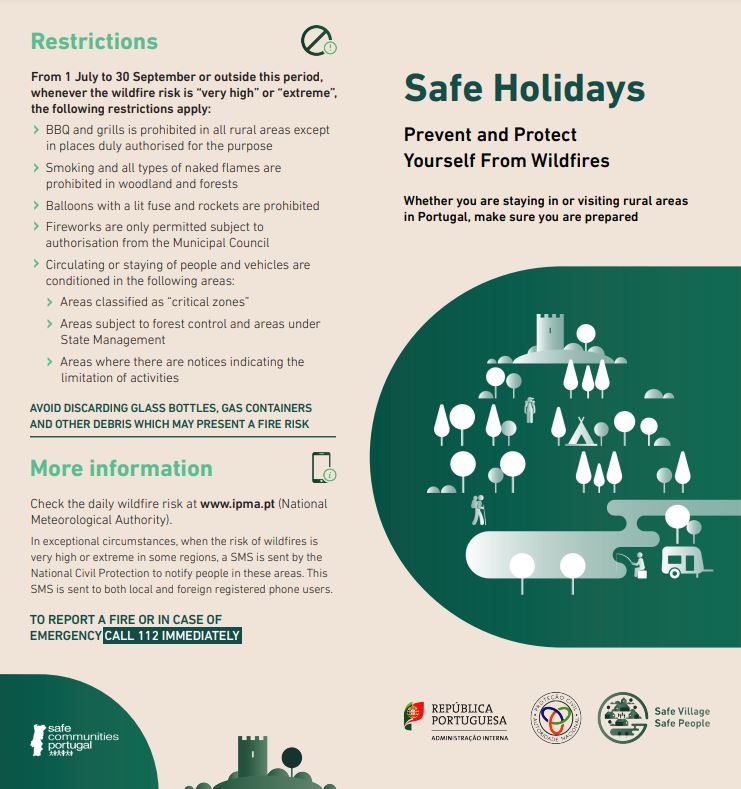
If you have decided to leave for a safer place, you should do so early if it is safe to do so...
- It is extremely dangerous to leave when roads maybe closed and full of smoke
- Rural fires move quickly so make sure you and your family know where your safer place is, how you will get there and when you will go
- You need to act the moment you know there is danger – do not wait and see
- Driving is very dangerous and stressful during a wildfire with smoke making it hard to see, fallen trees over the road and power lines down
- In the fire area, keep all the windows wound up and don’t get out of the car
- The speed of the fire could also trap you and burn your vehicle. Cars do not protect you from radiant heat
- Do you have electricity, to pump water through a hose? And sufficient water
- If you are not able to leave early, staying and sheltering may be your safest option. You will need to actively defend your property regardless of what you planned to do. Preparing your property will give you and your home the best chance of survival
Video Series – Safe Village – Safe people – Self Protection Measures
Safe Communities has assisted the Ministry of Internal Administration in the production of videos with English sub titles showing what action to take if you are affected by a fire. These can be viewed below:
All prevention and protection information is from official sources




